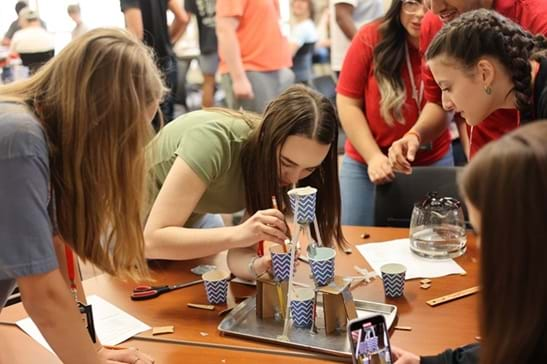
Summary
Students use rapid prototyping materials to build a self-supporting structure that uses gravity to allow water to flow through the structure, into two different Gatorade powders, and end in a final cup. They will learn about water flow and strong structures. They will also apply the engineering design process for this project.Engineering Connection
Mechanical and structural engineers focus on controlling how fluids such as water flow through systems and ensure the machine or structure can support its own weight. Mechanical engineers design machines, like the Gatorade machine you are building, that use gravity to move water and ensure the liquid flows smoothly through different parts of the system. They focus on how water moves and mixes with other ingredients. Structural engineers make sure the overall design is strong enough to hold all of the components and function properly.
Learning Objectives
After this activity, students should be able to:
- Describe the flow of water through a system (pipe or earth system) and the effects of gravity on water distribution systems.
- Support an argument that the gravitational force exerted by Earth on objects is directed down.
- Plan and carry out fair tests in which variables are controlled and failure points are considered to identify aspects of a model or prototype that can be improved.
- Generate and compare multiple solutions to a problem based on how well they meet the criteria and constraints of the design problem.
Educational Standards
Each TeachEngineering lesson or activity is correlated to one or more K-12 science,
technology, engineering or math (STEM) educational standards.
All 100,000+ K-12 STEM standards covered in TeachEngineering are collected, maintained and packaged by the Achievement Standards Network (ASN),
a project of D2L (www.achievementstandards.org).
In the ASN, standards are hierarchically structured: first by source; e.g., by state; within source by type; e.g., science or mathematics;
within type by subtype, then by grade, etc.
Each TeachEngineering lesson or activity is correlated to one or more K-12 science, technology, engineering or math (STEM) educational standards.
All 100,000+ K-12 STEM standards covered in TeachEngineering are collected, maintained and packaged by the Achievement Standards Network (ASN), a project of D2L (www.achievementstandards.org).
In the ASN, standards are hierarchically structured: first by source; e.g., by state; within source by type; e.g., science or mathematics; within type by subtype, then by grade, etc.
NGSS: Next Generation Science Standards - Science
| NGSS Performance Expectation | ||
|---|---|---|
|
MS-ESS2-4. Develop a model to describe the cycling of water through Earth's systems driven by energy from the sun and the force of gravity. (Grades 6 - 8) Do you agree with this alignment? |
||
| Click to view other curriculum aligned to this Performance Expectation | ||
| This activity focuses on the following Three Dimensional Learning aspects of NGSS: | ||
| Science & Engineering Practices | Disciplinary Core Ideas | Crosscutting Concepts |
| Develop a model to describe unobservable mechanisms. Alignment agreement: | Water continually cycles among land, ocean, and atmosphere via transpiration, evaporation, condensation and crystallization, and precipitation, as well as downhill flows on land. Alignment agreement: Global movements of water and its changes in form are propelled by sunlight and gravity.Alignment agreement: | Within a natural or designed system, the transfer of energy drives the motion and/or cycling of matter. Alignment agreement: |
| NGSS Performance Expectation | ||
|---|---|---|
|
MS-ETS1-1. Define the criteria and constraints of a design problem with sufficient precision to ensure a successful solution, taking into account relevant scientific principles and potential impacts on people and the natural environment that may limit possible solutions. (Grades 6 - 8) Do you agree with this alignment? |
||
| Click to view other curriculum aligned to this Performance Expectation | ||
| This activity focuses on the following Three Dimensional Learning aspects of NGSS: | ||
| Science & Engineering Practices | Disciplinary Core Ideas | Crosscutting Concepts |
| Define a design problem that can be solved through the development of an object, tool, process or system and includes multiple criteria and constraints, including scientific knowledge that may limit possible solutions. Alignment agreement: | The more precisely a design task's criteria and constraints can be defined, the more likely it is that the designed solution will be successful. Specification of constraints includes consideration of scientific principles and other relevant knowledge that is likely to limit possible solutions. Alignment agreement: | All human activity draws on natural resources and has both short and long-term consequences, positive as well as negative, for the health of people and the natural environment. Alignment agreement: The uses of technologies and any limitations on their use are driven by individual or societal needs, desires, and values; by the findings of scientific research; and by differences in such factors as climate, natural resources, and economic conditions.Alignment agreement: |
| NGSS Performance Expectation | ||
|---|---|---|
|
MS-ETS1-2. Evaluate competing design solutions using a systematic process to determine how well they meet the criteria and constraints of the problem. (Grades 6 - 8) Do you agree with this alignment? |
||
| Click to view other curriculum aligned to this Performance Expectation | ||
| This activity focuses on the following Three Dimensional Learning aspects of NGSS: | ||
| Science & Engineering Practices | Disciplinary Core Ideas | Crosscutting Concepts |
| Evaluate competing design solutions based on jointly developed and agreed-upon design criteria. Alignment agreement: | There are systematic processes for evaluating solutions with respect to how well they meet the criteria and constraints of a problem. Alignment agreement: | |
Materials List
Each group needs:
- 1 pair of scissors
- 1 ruler
- 1 tray (about 10 inches by 12 inches, to minimize messes and spills)
- 1 push pin (to poke small holes)
- Gatorade Gravity Machine Worksheet (1 per student)
For the entire class to share:
- small disposable paper cups
- straws
- duct tape
- unsharpened pencils
- string
- toothpicks
- Popsicle sticks
- plastic spoons
- cardboard
- 2 flavors of Gatorade powder
- water
- paper towels (for mopping up spills)
- tablespoon
Worksheets and Attachments
Visit [www.teachengineering.org/activities/view/uoo-2917-gatorade-gravity-machine-structure-design-activity] to print or download.Pre-Req Knowledge
A basic understanding of gravity and how water flows downhill.
Introduction/Motivation
How many of you have ever had hot chocolate from a vending machine or a cherry Coke from a soda fountain? Maybe you have used a slushie machine, or enjoyed soft-serve ice cream with two flavors mixed together? Have you ever wondered how those machines are designed?
These types of machines are designed by mechanical and systems engineers. Mechanical engineers focus on how the machine moves liquids, like how water or syrup flows and mixes with other ingredients. Systems engineers make sure all parts of the machine, such as the flavor compartments and the flow system, work together smoothly.
Today you are going to become mechanical and structural engineers and design and create machines like these. Here is the challenge: A local soccer team needs a gravity-powered Gatorade machine that can mix at least two Gatorade powder flavors together. This machine must stand on its own, have two separate compartments for the powders, and let water flow through both powders into one final cup. Oh, and the cup must be removable so the player can grab their Gatorade and drink it.
Let’s get started!
Procedure
Background
The basic principles of gravity and fluid flow are fundamental to designing a gravity-powered Gatorade machine. Gravity is the force that pulls objects downward, and it can be harnessed to move fluids from one place to another without the need for pumps. Fluid flow refers to how liquids move through pipes or channels, which can be influenced by factors such as the shape of the pathways, the incline of surfaces, and the rate at which the liquid is introduced. By understanding how gravity can control the direction of fluid and how to design channels that manage the flow effectively, engineers can create machines that mix and dispense liquids efficiently.
The engineering design process is a structured approach that engineers use to solve problems and create new solutions. It begins with understanding the problem, which involves grasping the needs of the client, the constraints of the problem, and the requirements that define a successful design. Engineers then conduct research to explore existing solutions, identifying what works and what needs improvement.
Next, engineers brainstorm a variety of potential solutions. Once they have a range of ideas, they analyze them to select the best one. The chosen design is then developed into a prototype—a working model of the idea. Prototyping and testing are critical steps in the process, as they provide valuable information about how well the design performs. This often leads to iterative cycles in which engineers revisit brainstorming and analysis to refine their solutions based on test results. It is common for initial designs to fail, which is why iteration is a key part of the design process.
Failure in design is not something to fear but rather an opportunity for growth. Engineers use failure to gather information and make improvements, a crucial concept to emphasize to students. It is important for students to understand that encountering failure in their designs is a normal part of the process and not a reflection of their abilities.
Rapid prototypes are early models created using inexpensive materials to test concepts quickly and affordably. These prototypes may not be perfect or durable but serve to validate the basic idea. If a design fails during this stage, it is often due to the limitations of the materials, not the idea itself. This concept helps students understand that early failures are a natural part of refining their designs and that stronger materials might solve the problems they encounter.
Before the Activity
- Gather building materials.
- Make copies of the Gatorade Gravity Machine Worksheet (one per student).
- Provide each group a tray upon which they will build their design.
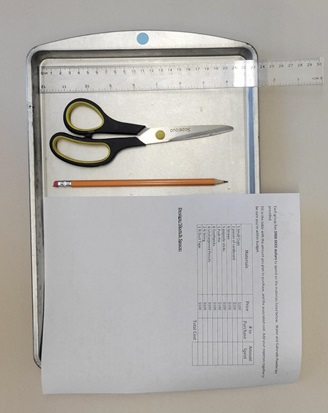
Before the activity, each team needs to have these tools for the build: scissors, ruler, pencils, and worksheet.
During the Activity
Day 1: Ask, Research, Brainstorm, and Design
Ask
- Divide the class into groups of three to five students. Distribute copies of the Gatorade Gravity Machine Worksheet (one per student).
- Review the engineering design process.
- Ask: “Who knows what the engineering design process is?” (Answer: The engineering design process is a series of steps engineers use to solve problems and create new things.)
- Show a diagram of the engineering design process for reference.
- Briefly describe each step:
- Ask: In this step, identify the problem you need to solve, making sure to note the requirements and limits or constraints.
- Imagine: During this step, you brainstorm ideas and think of all the different ways you could solve the problem. This is where creativity comes in!
- Plan: After brainstorming, you choose the best idea and make a plan. You might sketch it out, make lists, or figure out what materials you will need.
- Create: Now that you have a plan, you build your design based on the plan. This could be a model or a prototype—a smaller version of your final idea.
- Test: Once your design is built, you test it to see how well it works. This is where you find out what needs improvement.
- Improve: After testing, you go back and make changes to improve your design. Engineers often repeat this step several times until they get the best solution.
- State the problem: A local soccer team needs a gravity-powered Gatorade machine that can mix at least two Gatorade powder flavors together. This machine must stand on its own, have two separate compartments for the powders, and let water flow through both powders into one final cup. Finally, the cup must be removable so the player can grab their Gatorade and drink it.
- Convey the requirements and limits/constraints based on the stated problem.
- Requirements limits/constraints:
- The machine must stand on its own (no hands holding it together).
- Water must be poured into a cup without Gatorade powder first.
- Gatorade powders must be kept in two separate cups.
- The machine must fit on the provided tray.
- The final cup must be removable.
- Have students fill out the “Ask” section of their Gatorade Gravity Machine Worksheet. (Note: Before moving on, make sure students understand the problem, requirements, and constraints.)
Research
- Give each group two cups (one with water).
- Ask each group how they can get water from one cup into the other while keeping both cups upright.
- If needed, explain important aspects for them to consider in their design, such as direction of water flow, and to think of things such as fountains or children’s water tables to help them produce ideas.
- Give each group 5-10 minutes to play around with their cups, water, and ideas.
- Potential ideas:
- Tube or straw: Place a tube or straw in the first cup and direct the other end into the second cup. The water will flow through the tube due to gravity if the tube is positioned correctly.
- Spout or funnel: Use a small spout or funnel to channel the water from one cup to the other. The spout or funnel should be angled so that gravity helps guide the water into the second cup.
- Siphoning: Start a siphon by filling a tube with water and placing one end in the first cup and the other end in the second cup, lower than the first cup. Once water starts flowing through the tube, it will continue to transfer from the first cup to the second due to gravity.
- Inclined plane: Tilt the first cup slightly to pour water into the second cup, using a sloped surface or inclined plane to help guide the water flow while keeping both cups mostly upright.
- Have students answer the questions in the “Research” section of their worksheet.
- (optional) Have students research machines through which water flows or machines that mix two substances together.
Imagine
- Show students the materials available to make their machines.
- Remind students to think of machines through which water flows or machines that mix two substances together. Remind them that engineers often draw inspiration from existing designs when creating something new. You can also ask the students to consider the following:
- How will the water mix with the Gatorade powder?
- Does the water need to flow slowly or quickly?
- Which direction does the water naturally flow?
- Give students 10 minutes to individually brainstorm and quickly sketch 5-6 ideas in the “Imagine” section of their worksheet. (Remind students that this step should be completed on their own, WITHOUT talking to their teammates. This is important because will help the team generate lots of unique ideas. Then, when all of the ideas are shared, the team will have a variety of ideas to choose from to create the best design.)
Plan
- Bring the class back together.
- Introduce the class to new constraints:
- Each group has $900 to spend on their machine. (Show students the budget and material list table in the “Plan” section of the worksheet.)
- Judging Criteria:
10 points for each $100 saved
100 points if water makes it to bottom cup
50 points if the water only mixes with one powder OR 150 points if water mixes with both powders
10 points for each cup the water reaches
- Give each group 15 minutes to share their ideas and produce ONE group design. Remind students that the team design can be one design or a mixture of multiple brainstormed ideas.
- Once each group agrees on a design, have each team member draw the group design in the “Plan” section of their worksheet. Remind student to identify the materials that will be used and to indicate the dimensions of components where possible.
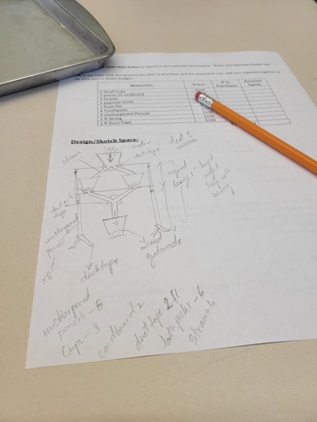
After students brainstorm individually, they come up with one team drawing for their design. - Tell the students that once they have their sketch and materials list, they should raise their hand to have their designs approved.
- Approve teams’ designs. Make sure they have followed the rules, stayed within their budget, and have a design where water flows downhill.
Day 2: Build and Test
Create
- Once their design is approved, let each team “buy” their materials and begin building.

Three teammates work together to build the structure of their Gatorade machine. - Allow students to build for at least 30 minutes. During this time, they are allowed to make changes from their design, buy more materials, and even do an unofficial test with just water.
- Encourage your students to unofficially test their design along the way to make sure the water will flow. This is important in engineering, as we use tests to gather information and improve designs.
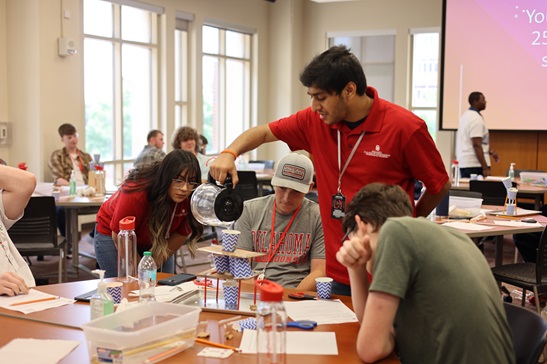
The team in this picture is doing a first initial test with just water to make sure their device works the way they want.
Test
- Once all teams have their structures built, it is time to test!
- Test the designs by placing 2 tablespoons of Gatorade powder in two separate cups of their design. Students can indicate which cups should contain powder.
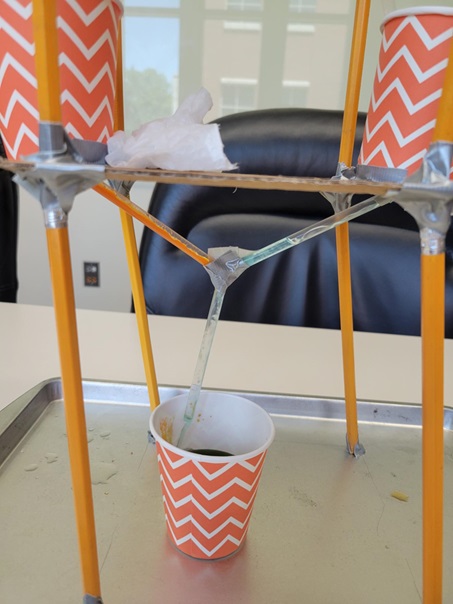
Here is one example of the final test where Gatorade flows from two cups into the final cup. - Pour about 6-12 oz of water through the machine. Students can indicate which cup the water should be poured into.
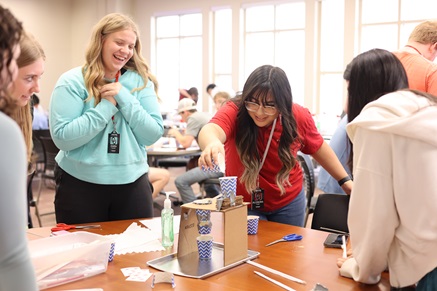
The team in this picture is doing their final test. The Gatorade is placed in two different cups, and the water is being poured by the instructor into an empty cup. - Have the students tally up their points for their design based on the criteria.
Improve
- Once all designs have been tested, have students write down what worked in their design and what needed improvement in the “Improve” section of their worksheet.
- To wrap up, it is important to have a discussion with the students about how engineers use testing to gain information and then go back through the design process to improve their design. This way any students who experienced failure can be taught that failure is information used to improve the design and does not mean they did not have a good idea.
- For example, you can say: "Let's talk about how engineers use testing to improve their designs. When engineers test something and it doesn’t work perfectly, that’s not a failure—it’s a chance to learn. Testing gives them important information about what worked and what didn’t, so they can go back and make their design even better. So, if your design did not work exactly how you planned, that’s okay! It just means you have learned something new, and you can use that knowledge to make improvements. Remember, no design is perfect the first time—that’s why the design process is all about trying, testing, and improving."
- Potential questions to ask the class:
- Why do you think engineers test their designs? What can they learn from testing?
- If your design did not work the way you expected, what information did you gain from that? (This will encourage students to think about how failures provide useful insights.)
- How can failure be helpful in the design process? (This question reinforces the idea that failure is a step toward improvement, not a setback.)
- What changes would you make to improve your design based on your test results? (This invites students to connect what they learned to the next steps in the design process.)
- Can anyone think of an example where something failed but was later improved? (Asking for real-world examples shows students how failure is a normal and important part of innovation.)
- How does this process help engineers create better designs? (This question encourages students to recognize the value of iteration and continuous improvement.)
Vocabulary/Definitions
brainstorm: To think up ideas as a group to solve a problem.
gravity: A force that pulls objects toward each other.
rapid prototyping: The rapid creation of prototypes of a new product for demonstration and research purposes using low-cost materials.
water flow: Movement of water from one place to another.
Assessment
Pre-Activity Assessment
Class discussion: Lead the class in a discussion about the engineering design process. You will want to introduce the design process to your class ahead of the activity.
Research/Water Flow Activity: In small groups, give the students two cups (one with water). Ask them how they can get water from one cup into the other while keeping both cups upright.
Worksheet: Have students answer the questions in the “Ask” and “Research” sections in their Gatorade Gravity Machine Worksheet.
Activity Embedded (Formative) Assessment
Worksheet: Have the students work on their Gatorade Gravity Machine Worksheet. Make sure each student draws their brainstormed idea on their paper in the design space.
Check design: When you check their design, you will want to have the students explain their idea to you. You want to ask them: (1) How does the water flow through the machine?, (2) Where does the Gatorade powder go?, (3) Explain why certain materials were chosen, (4) Is their final cup removable?, and (5) How they worked together to make this design.
Post-Activity (Summative) Assessment
Worksheet: When the activity is over, have the students reflect on the following questions. (Note: There are no specific answers to look for with these questions, but they should be thoughtful):
- What worked well in your design?
- What would you change if you could do this again or have more time/money to complete the project? (Answer: The only wrong answer is having nothing they would change; I would preface this question with there is always room to improve even when things go well. This is an important part of engineering. Also want them to see their “failure” as information they could use to improve next time.)
- What was the most difficult aspect?
- Were you surprised by anything during the testing?
Class Discussion: Discuss how engineers use testing to gain information and then go back through the design process to improve their design. Relate it to students’ process during the activity.
- What steps did you take to make your design? (Want to make sure they used the design process steps.)
- What did you see in any other group’s designs that you really liked?
Troubleshooting Tips
Make sure students use safe scissor practices.
Activity Scaling
- For lower grades, you can take away the budget and material limits and allow them to be more open with their design options.
- For older/ advanced students, you can decrease the amount of money you will give them to make the design. You can also require them to have a specific flow rate that they must measure, and/or a specific percentage of water that is not lost in the system.
Subscribe
Get the inside scoop on all things TeachEngineering such as new site features, curriculum updates, video releases, and more by signing up for our newsletter!References
Jackson, M., et al. "Family engineering: An activity & event planning guide." Portland, OR: Foundation for Family Science & Engineering (2011).
Copyright
© 2024 by Regents of the University of Colorado; original © 2024 University of OklahomaContributors
Tierney Harvey, Luke Kirk, Krish Pandit, Alondra Ortega, Haley TaffeSupporting Program
The Sooner Engineering Education (SEED) Center, University of OklahomaLast modified: September 24, 2024







User Comments & Tips